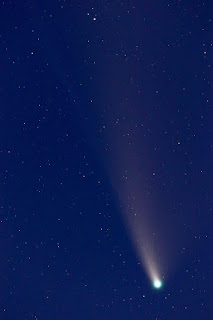A comet, often called a dirty snowball, is a frozen collection of rock, dust, and gases that orbits the Sun. When a comet approaches the Sun, heat causes the comet's shape to change. Frozen gases thaw, creating a tail that can stretch millions of kilometres into space. Now the comet looks like another one of its nicknames—a long-haired star!
Night sky observers have been aware of comets for a very long time. Chinese astronomers kept records that show Halley’s Comet was observed in 240 B.C. Scientists are very interested in studying comets because they formed at the same time as our solar system. Their research may help scientists understand how the building blocks of life reached Earth.
An exciting new comet was discovered on March 27, 2020. Visible with the naked eye from a dark location, the new comet, named NEOWISE, is five kilometres (three miles) wide, with a tail stretching hundreds to thousands of kilometres. Its name comes from the initials of NASA’s satellite observatory: the Near-Earth Object Wide-field Infrared Survey Explorer. Though billions of comets exist, Comet NEOWISE is one of only 3,655 identified comets.
Observe NEOWISE
In the northern hemisphere, NEOWISE is visible in the northwest sky after sunset. You can find it in the vicinity of the Big Dipper. I was able to spot it with binoculars, which made it appear like a great, pale smudge across the sky. A telescope brings it into better focus, as seen in this photo taken near Cold Lake, Alberta, by Shaula Corr of aurorasbycorr.com(Visit Shaula's website to view more comet images. You can even order a framed print.)
NASA offers tips on how to view NEOWISE, which will appear higher in the sky into August. Look soon because the comet is already dimming as it travels to the outer region of the solar system. Once it is out of sight, NEOWISE will not reappear for another 6800 years.
Quick Facts about Comets
 - Comets have egg-shaped orbits.
- Comets have egg-shaped orbits.
- When a comet travels far enough away from the Sun, its tail will disappear.
- A comet that gets too close to a planet or the Sun may crash into it!
-The center of a comet, called its nucleus, can be the size of a small town. When a comet gets close to the Sun, its head will grow larger than most planets.

 - Meteor showers, which can last from hours to days, occur when Earth passes through a part of the sky where a comet left behind dust particles. That’s why meteor showers are visible around the same dates every year.
- Meteor showers, which can last from hours to days, occur when Earth passes through a part of the sky where a comet left behind dust particles. That’s why meteor showers are visible around the same dates every year.
Discover More about Space
I had the pleasure of writing about comets in my most recent book: (National Geographic Kids). To discover how to go "dot-to-dot in the-sky" to use the constellations as a map to find comets and other night sky objects, see these titles in my You will also find tips for spotting meteors. Next time you see one, think of the comets that have passed through our part of the universe. Space is an amazing place!
Joan Marie Galat is the author of more than 20 books for children and adults. Many of her titles focus on astronomy, space, and other STEM/STEAM topics.

No comments:
Post a Comment